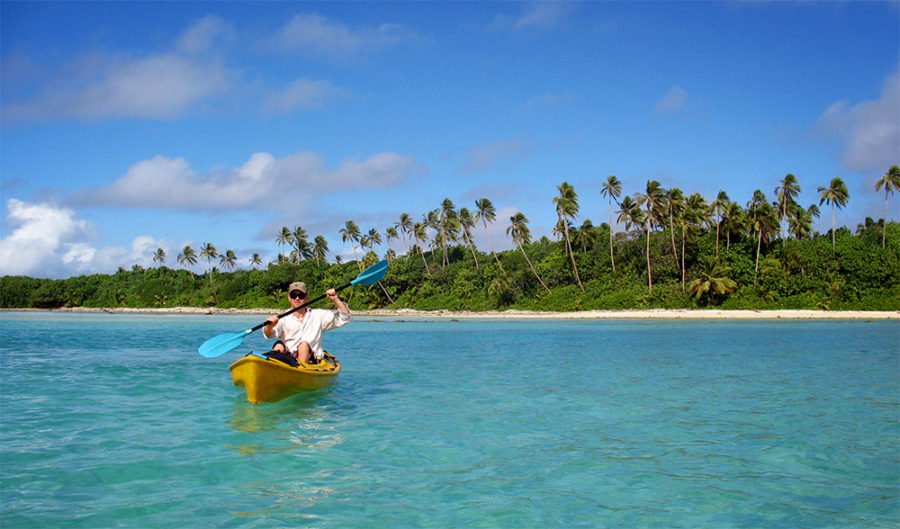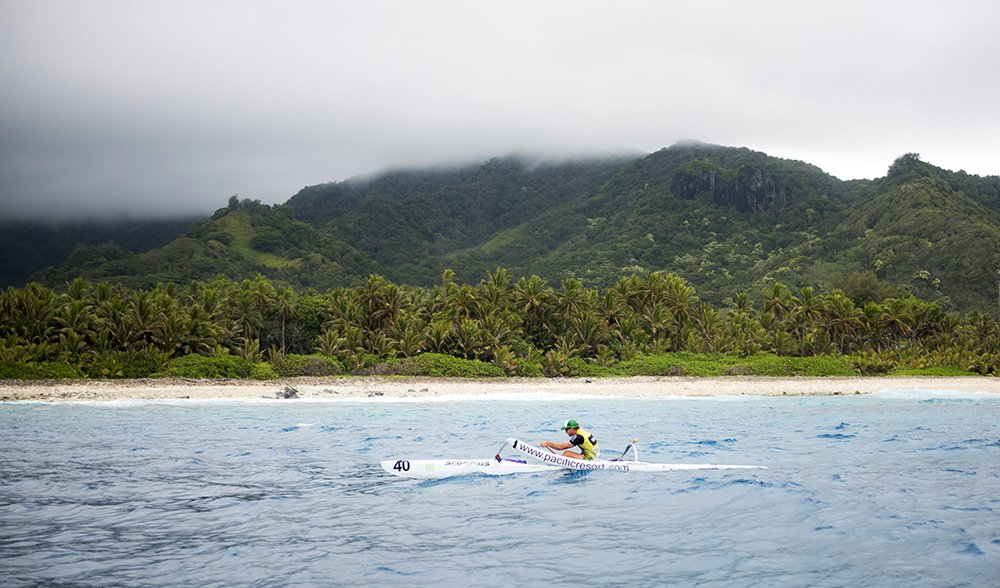The Cook Island life

DOLLOPS OF MUD ricochet off my tyre and splatter up my back, my feet slop about in waterlogged shoes and my legs burn.
I’m sweating, panting and hollering with delight as I hit the river, throwing walls of water off to each side. Bouncing off the rocks, I’m chasing newfound friends up the muddy bank. We’ve been racing mountain bikes through the rainforest under the hot tropical sun, grinning like little kids all morning. Life is perfect.
Is anyone up for a spontaneous MTB circumnavigation of a tropical island? Yes please. These are the travel moments to live for, the ones that can’t be planned or bought, but are nevertheless guaranteed when you say yes to opportunity and chat with locals to find the gems beyond the guidebooks. You see, mountain biking is only just emerging in the Cook Islands, and right now there’s a great opportunity to recce the secret gems and pioneer the best trails.
This is exactly what I’ve come to the Cook Islands to discover: an adventure-packed tropical paradise far beyond its rightly deserved reputation as a romance or relaxation destination.
RELATED VIDEO: Explore the beauty of the Cook Islands
Every journey to the Cooks starts in Rarotonga, the playful main island, which has struck a comfortable balance between commercial tourism and unspoiled nature. Within hours of arriving, I’ve struck up a conversation with hotelier Craig who extends the mountain-biking invitation. By 8am he has mustered bikes, helmets, cold water and even a little loaned lycra! This is typical of the above and beyond hospitality you can expect to experience in the Cooks, where it’s not unusual for your hosts to become your friends on Day 1.
Due to time constraints, I stuck to the southern group of islands on this trip starting with Aitutaki, for its impossibly blue picture-postcard lagoon; Aitu, for its quiet remoteness, limestone caves and rich nature; and Rarotonga, for it’s vibrancy set amongst craggy mountains, fringed by white-sand beaches and its famous Vaka Eiva festival.
History lesson

The annual Vaka Eiva Festival is a popular annual paddling event held in Rarotonga. (Photo credit: Mark Watson)
Around 1500 years ago Polynesian people from Tahiti and Samoa took to the sea in handbuilt, doubled-hulled Vaka (enormous mahogany canoes lashed together with coconut rope) and set sail for neighbouring lands, conquering islands one by one before going to war with each other over land, trade and maidens. When Captain Cook sailed through in the late 18th century, he pulled the string of islands together by naming them the Hervey Islands (before they were later renamed in his honour). Official British colonisation followed and along with new trade came an influx of missionaries who aimed to convert the population. To this day, the Cook Islanders are predominantly Christian and you’ll find fine white limestone churches on nearly every corner.
The Christian conversion over 200 years ago isn’t without controversy, as it quickly stamped out the Islands’ traditional culture. Carved idols were burnt, artifacts destroyed, and sacred meetings and ceremonies outlawed. One local, Ngaakitai Pureariki, who runs the Punarei Cultural Tour, has dedicated his life to reviving the native culture, and he holds no punches in attributing his people’s lost sense of identity to the missionaries. His life goal is to uncover cultural relics in order to piece the past together for his nation to better understand itself.
In 1901 the Cook Islands were annexed from the British Empire to the Dominion of New Zealand before becoming independent in 1965. Today it is a mix of Polynesian/Christian culture with a population of just 15,000, and made up of 15 islands.
Aitutaki

The Perfect sunset. (Photo credit: Mark Watson)
Aitutaki Lagoon
www.thevakacruise.com
One of the world’s largest coral lagoons, Aitutaki Lagoon is stunning. You can day-trip to the lagoon, but you’d be better off staying on Aitutaki for a night or two. The lagoon is home to 15 islets, many of which are uninhabited. If you ever had a castaway dream of spending a day on a deserted tropical island, this is the place. You can take the The Vaka Lagoon Cruise from O’otu beach and enjoy a spectacular day on the water that includes a local lunch, or you can make your own way on a Hobie Cat, stand-up paddleboard, windsurfer or kayak. Whatever the choice, make sure you jump in the water and go snorkelling.
Cultural tour
www.aitutakiculturaltour.com
The Punarei Cultural Tour is well worth experiencing on a visit to Aitutaki. This is not a tacky ‘cultural dance’ type of show; rather an opportunity to have a frank conversation with passionate local Ngaakitai Pureariki, who will enlighten you on recent archaeological and historical discoveries. You will visit the sacred Paengariki Marae, an ancient meeting ground and the site of on-going excavations that are uncovering the forgotten native culture. Ngaakitai will entertain and educate you with incredible stories, some alluding to a cannibal past, that have been hidden for more than two centuries.
Atiu

Pools below Atiu. (Photo credit: Mark Watson)
An island of Caves
www.atiutoursaccommodation.com/tours.html
There are few places in the world like the little island of Atiu (pronounced like Ah-Chu, as if you are sneezing). Unspoilt and made up of fossilised coral covered in dense rainforest, it’s secluded enough to feel off the beaten track and is a nature lover’s dream. This is the place where you can stumble upon an empty beach, realise you’ve forgotten your swimmers and jump in anyway, because there isn’t a soul in sight.
Anatakitaki Caves
Atiu stole my heart immediately and while what lies above the ground is beautiful, what lies below is equally intriguing.
The island is perforated with caves, the most striking of which are the Anatakitaki caves. Clambering down a ladder into a partially collapsed sinkhole, you will come to three enormous caverns filled with stalagmites and stalactites. These caves are home to an extraordinarily rare bird called the Kopeka, a tiny swiflet that lives deep within the pitch-black caves. Like any bird it happily sings outside, but to return to its nest inside the cave it uses clicking sonar to navigate like a bat. Why they live in the caves is a mystery, but this is the only place in the world you can visit them.
Subterranean Swimming
Being a limestone cave system means there are places where you can access the water table. Just off the Kopeka caverns is a spectacular subterranean pool, filled with refreshing, crystal clear fresh water. Light the candles beside the pool for some ambiance and you have a natural swimming spot that’s completely hidden from the rest of the world.
Burial Caves
Some of the caves on the island were used as burial chambers for ancient warriors. The cave of 500 is open for exploration, although a guide is required. There are about 60 viewable human skeletons resting within the cave, and educated guesses put them at between 300-400 years old (they haven’t been dated as there are fatal superstitions around removing the remains). While it sounds creepy, it’s surprisingly peaceful and more a lesson in history and human anatomy than a ghost tour.
Rarotonga

Partway through the The Cross Island Trek in the Takitumu Conservation Area. (Photo credit: Mark Watson)
Cross Island Trek
www.pastreks.com
Throw a pair of decent shoes in your luggage to take advantage of the great day hikes in Rarotonga. The Cross Island Trek in the Takitumu Conservation Area is fantastic, and you will weave through the forest, cross the mountains and emerge on the other side of the island. It starts in Avatiu valley and ends at Papua Waterfall in Vaima’anga.
The spectacular rocky outcrops at the top give you the best vantage point. Your heart rate is set to rise as you scramble up bolted chains in the rock. Tthe cool summit breeze and the incredible vistas are a wonderful reward for the hard work.
Outrigger Canoeing (Vaka Eiva)
www.vakaeiva.com
Outrigger canoeing is a popular local sport that has a rich history in Polynesian culture. Each year in November hundreds of international paddlers are invited to take part in the Vaka Eiva canoeing festival. Teams from as far as Europe, Canada and Australia flock to the Cooks to compete in the various races, the most famous of which is the Round Raro relay that sees paddlers tackle the often turbulent seas beyond the lagoons and do a loop of the main island.
Paddler or spectator, the vibe is one of friendly rivalry, adventure and camaraderie. If you get the opportunity to participate, you’re sure to have a great time.
Diving
www.thedivecentre-rarotonga.com
Being volcanic, Rarotonga is completely surrounded by healthy hard coral reefs abundant with rare marine life. While you won’t see any soft corals in the waters (because of the topography) the reef is truly alive and visibility is excellent. The different sides of the island offer 35 unique sites, including drop-offs, canyons, passages, wrecks and even caves. It’s gorgeously warm with the water ranging between 23-28 degrees.
Head out with the passionate team from The Big Fish Dive centre who will soon convince you that one dive is not enough, so go for a double. You might get lucky and see eagle rays, reef sharks, turtles, Maori wrasse, trevallies and more. If you go in winter you might get lucky and find yourself in the company of a humpback!
If diving isn’t for you, there’s plenty of snorkelling in the lagoon and the team at Big Fish will sort you out with some rental gear.
Kite surfing – Muri Beach
www.kitesup.co
Welcome to a kite surfing Mecca: the calm, shallow lagoon that encompass Rarotonga is a perfect playground for kite surfers, both beginners and experts. The consistent winds are perfect and the lagoon provides a security blanket of safe water should you find yourself spending more time washing your kite than flying it.
Skipping across the water, powered by the breeze, gives rise to a particular ecstasy. It’s the exhilaration of flying and the bliss of surfing rolled into a colourful kite above you. While it is a sport that requires a bit of cultivation and persistence, it’s worth it… I would suggest a few lessons with KiteSup at Muri Beach.
Luxury beachside villa
www.sea-change-rarotonga.com
The Sea Change Villas on Rarotonga are hard to beat for a little luxurious indulgence; they even leave cold beer and wine in the fridge! Make sure you use the house paddleboards and head out at dusk to watch the sunset over the water. Privacy and location are unparalleled; you only live once, so spoil yourself.
The Essentials
Flights: Air New Zealand has a weekly non-stop flight from Sydney and daily flights via Auckland. You need a return ticket, which allows you to stay for up to 31 days. www.airnewzealand.com.au
Stay: There are plenty of accommodation options available to suit all budgets from families to couples to those flying solo. In Aitutaki, Aretai Villas offers a homely, comfortable and affordable beachfront villa. www.aretaibeachvillas.com
Eat: On Atiu Island, the only place to get a great feed and roll into bed in a lovely villa, complete with a swimming pool, is at Atiu Villas. www.atiuvillas.com
READ MORE:
- Exploring the New Zealand Fiorland
- Paddling the traditional way in the Cook Islands
- New Zealand on two wheels
- Exploring New Zealand’s Milford track

